Abstract
This article describes a MgCl2-supported Ziegler-Natta catalyst for propylene polymerization prepared via an in situ emulsion technique with new surfactants. The effect of preparation conditions such as the TiCl4/toluene molar ratio, TiCl4-contacting temperature, amount of phthaloyl dichloride, stirring rate, mixing time of TiCl4/toluene with the Mg complex, and the n-butyl chloride loading was investigated in detail. Scanning electron microscopy and laser particle size analyzer measurements showed that the catalyst particles exhibit a perfectly spherical shape, narrow particle size distribution, and low fine powder content. Energy-dispersive X-ray spectrometry indicated that the Ti, Mg, and Cl elements were evenly distributed throughout the particles. Powder X-ray diffraction measurements indicated the presence of δ-MgCl2 in the catalyst, and FTIR and GC-MS studies confirmed the presence of in situ formed di(ethylhexyl)phthalate (DEHP). Bulk polymerization of propylene using the catalyst was studied, and it was found that the catalyst displayed high activity, high bulk density with high stereospecificity, and excellent hydrogen sensitivity. The polymer produced by the catalyst has a narrow particle size distribution with a low fine powder content.
1. Introduction
Since their discovery in the 1950s, Ziegler-Natta catalysts have been applied in the production of polyolefins [1,2,3,4]. During polyolefin production, the morphology of the polymer particles strongly affects the equipment operation, and the loss of polymer morphological control may give rise to many industrial operating problems (such as fouling and broadening of the reactor residence-time distribution). It is now widely accepted that the morphology of polymer particles is mainly determined by the morphology of a parent catalyst through the replication phenomenon [5,6].
MgCl2 has been known as the most widely used support for Ziegler-Natta catalysts with high catalytic activity and high performance [7,8,9,10,11]. Typically, three methods have been used to prepare activated MgCl2 supports for Ziegler-Natta catalysts, namely, ball-milling (physical route), recrystallization (chemical route), and the chemical reaction method (chemical route) [12,13,14,15,16]. Due to the difficulties in obtaining spherical supports via physical routes, the activation of MgCl2 now usually performed using chemical methods. The recrystallization of MgCl2 in an alcoholic hydrocarbon solution is a well-known method for preparing a spherical catalyst. For example, spray crystallization, spray drying, and fast quenching methods have been widely applied [17,18,19,20]. However, some problems remain to be solved (e.g., low adduct yield, and complexity of the process). Additionally, in the synthesis of the MgCl2 support via this method, it is not easy to obtain compact and perfect morphology because it is difficult to control the alcohol content in the MgCl2-alcohol complexes; this affects the porosity and the strength of the catalyst particles and the polymer particle morphology [5,6]. Moreover, the fragmentation of the catalyst particles may result in an undesirable polymer morphology, formation of fines, and reactor fouling.
Compared with recrystallization, the chemical reaction method is less used by researchers, because it is difficult to obtain the MgCl2 support with a perfect spherical shape and a smooth surface. In this aspect, the emulsion technique represents a unique approach for the preparation of spherical catalysts. Compared with the conventional polypropylene catalysts that are prepared by fixing TiCl4 to the pre-obtained MgCl2 alcohol adduct, Borealis Technology Oy [21] obtained a solid self-supported Ziegler-Natta type catalyst during the emulsion with the TiCl4-fixing process. Due to the perfectly spherical shape, low TiCl4 amount, and mild reaction temperature, these catalysts are very attractive to the polypropylene industry.
The emulsion technique represents a unique approach for the preparation of spherical catalysts. In the present work, we report a Ziegler-Natta propylene polymerization catalyst prepared by the in situ emulsion technique with new surfactants (dodecyl methacrylate and poly-dodecene). The catalyst was analyzed and characterized, and the catalyst preparation conditions and its performance were investigated in detail as described in Scheme 1 through a bulk polymerization study.
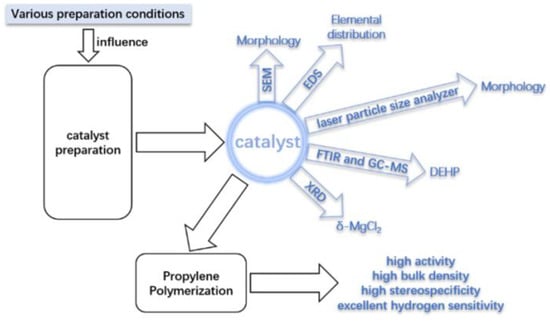
Scheme 1.
The catalytic process studied.
2. Results and Discussion
2.1. Effect of Catalyst Preparation Conditions
2.1.1. Influence of Surfactant
The obtained scanning electron microscopy (SEM) images show the effect of different kinds of surfactants on the morphology of the catalyst (Figure 1). In the absence of surfactant, the catalyst particles exhibited nonspherical morphology (Figure 1a), while individually adding dodecyl methacrylate in the emulsion system led to an increase in the dispersity of the catalyst particles (Figure 1b). Although the mean particle diameter was obtained in the 10–15 μm range with a narrow distribution as well as granular shape, the surface of the catalyst was not smooth enough. To some extent, the dodecyl methacrylate tended to stabilize the interface between the two phases, but turbulence significantly influenced the shape of the emulsion droplets. Adding the poly-dodecene individually to the emulsion system may have reduced the turbulence and resulted in a smooth surface, but in the absence of an emulsion stabilizer, the particles conglutinated (Figure 1c). By applying both the emulsion stabilizer (dodecyl methacrylate) and turbulence reducer (poly-dodecene) simultaneously, a perfect spherical morphology with an approximately 20 μm particle diameter was observed (Figure 1d).
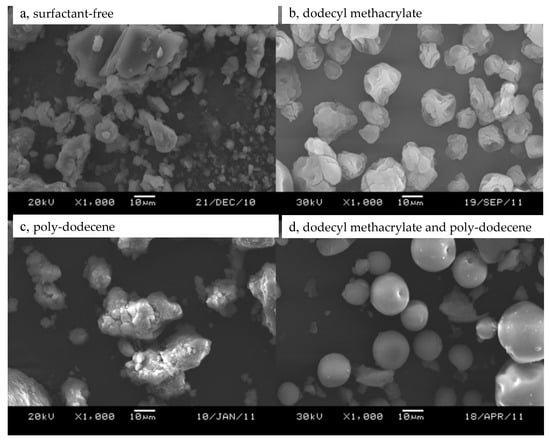
Figure 1.
Morphology of the catalyst.
2.1.2. Influence of the TiCl4/Toluene Molar Ratio
Changing the ratio of polar (TiCl4, isooctyl alcohol, etc.) and nonpolar (heptane and toluene) phases in the emulsion system may also influence the morphology and diameter of the catalyst (Figure 2). At lower TiCl4/toluene molar ratios, spherical particles were observed along with the ellipsoid and rod-shaped morphologies (Figure 2a). To eliminate the ellipsoid and rod-shaped particles, the TiCl4/toluene molar ratio was increased, obtaining only spherical particles of the catalyst (Figure 2b). Upon increasing the nonpolar ratio, the emulsion droplets could not maintain their original shape.
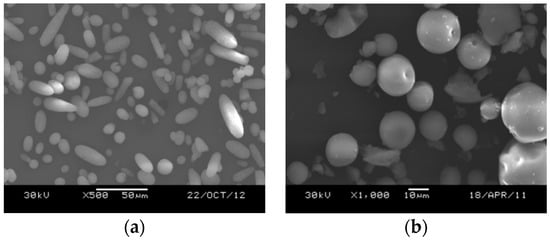
Figure 2.
SEM images of the catalyst with different TiCl4/toluene molar ratio: (a) 1:3; (b) 1:1.
2.1.3. Influence of TiCl4-Contacting Temperature
Figure 3 shows the effect of the TiCl4-contacting temperature on the diameter and morphology of the catalyst. The particles’ diameter exhibited a linear relation with the TiCl4-contacting temperature, and the D50 diameter of the catalyst increased from 19 μm to 30 μm as the temperature was changed from −25 °C to 25 °C. The surface morphology of the catalyst particles was also related to the temperature. Additionally, the particles obtained at higher temperatures exhibiting a broader diameter distribution. The small particles displayed regular spherical morphology while the larger particles collapsed (Figure 3b) or even cracked (Figure 3c). The lower temperature (−25 °C) was the optimum temperature to help maintain the smooth surface and uniform diameter of the particles (Figure 3a).

Figure 3.
Morphology of the catalyst with different TiCl4-contacting temperatures. (a) −25 °C; (b) 0 °C; (c) 25 °C.
2.1.4. Influence of Phthaloyl Dichloride
The different amounts of phthaloyl dichloride also influence the diameter and morphology of the catalyst particles (Figure 4). Utilizing 0.01 mol of phthaloyl dichloride resulted to a spherical morphology, with the diameter in the 10–15 μm range (Figure 4a); when the amount was reduced to 0.005 mol, the spherical morphology was still maintained, but the particle diameter decreased to less than 10 μm (Figure 4b). A further decrease to 0.0025 mol led to an oval shape morphology with a cracked surface (Figure 4c). The preparation of the catalyst without adding phthaloyl dichloride produced only a fine powder with no spherical particles (Figure 4d). Since the amount of phthaloyl dichloride affects the nucleation process, in its absence, the MgOR directly reacts with TiCl4, releasing a tremendous amount of heat that consequently produces a large number of nuclei and inhibits the crystal growth process, resulting in a fine powder.
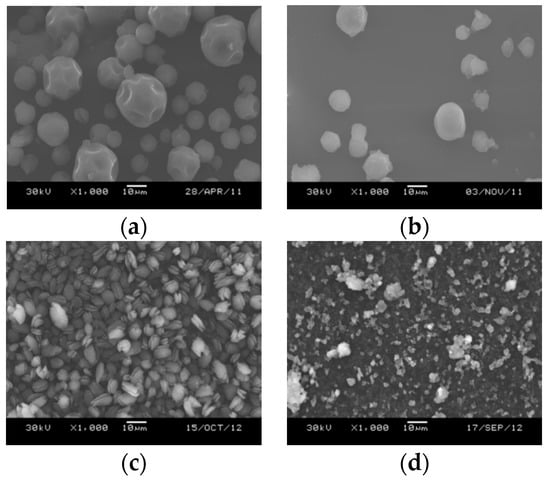
Figure 4.
Morphology of the catalyst with different amounts of phthaloyl dichloride. (per 0.05 mol Mg): (a) 0.01 mol; (b) 0.005 mol; (c) 0.0025 mol; (d) 0 mol.
2.1.5. Effect of the Stirring Rate
Increasing the stirring rate from 200 to 400rpm may lead to irregular shapes. Some particles were broken during the formation process carried out with a high stirring rate, resulting in a higher fine powder content. Moreover, the droplets could not maintain a stable spherical shape in a highly chaotic environment and therefore rarely grew into spherical shapes (Figure 5).

Figure 5.
Morphology of the catalyst with different stirring rates: (a) 200 rpm; (b) 400 rpm.
2.1.6. Influence of the Mixing Time of TiCl4/Toluene with Mg Complex
Spherical particles were produced by adding the Mg complex to TiCl4/toluene at a low rate (57 mL of Mg complex was added to TiCl4/toluene in 60 min) using a peristaltic pump, as shown in Figure 6a. Increasing the mixing speed (57 mL of Mg complex was added in 2 min) changed the spherical particles to an irregular shape, which may be due to the highly exothermic reaction promoting the formation of a large number of nuclei and inhibiting the crystal growth, obtaining fine powder (Figure 6b).
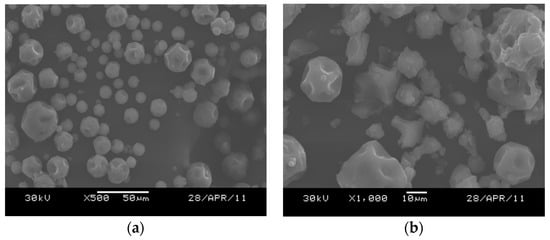
Figure 6.
Morphology of the catalyst: (a) mixing TiCl4/toluene with Mg complex in 60 min; (b) mixing TiCl4/toluene with Mg complex in 2 min.
2.1.7. Influence of n-butyl Chloride
The n-butyl chloride also significantly affects the morphology and the surface of catalyst particles. In the presence of n-butyl chloride, most of the catalyst particles (except the large particles that showed shrinking surfaces) exhibited spherical shapes with a smooth surface and a particle diameter of approximately 20 μm (Figure 7a). In the absence of n-butyl chloride, the particles maintained the spherical shape but were slightly aggregated and showed fine folds on their surfaces (Figure 7b).
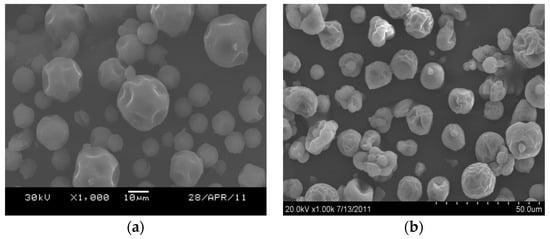
Figure 7.
Morphology of the catalyst: (a) with n-butyl chloride; (b) without n-butyl chloride.
2.2. Characterization of the Catalyst
2.2.1. Elemental and Particle Size Analysis of the Catalyst
Table 1 shows the catalyst contents (wt %) and the size distribution of the catalyst particles. The results show that the catalyst particle distribution was concentrated at approximately 20 µm with a narrow particle size distribution and with less fine content. The EDS measurements of the catalyst show that the Mg, Cl, and Ti elements were distributed homogeneously in the catalyst system (Figure 8). As the polymer particle morphology is mainly determined by the morphology of the catalysts through the replication phenomenon, the low fine content of the catalysts results in a low content of polypropylene fine powder and consequently avoids equipment blockage.

Table 1.
Element and particle size analysis of the catalyst.

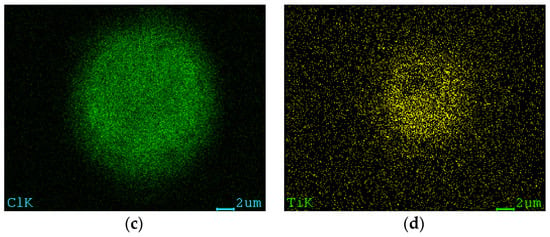
Figure 8.
Energy dispersive X-ray results for the catalyst. (a) The SEM image of the total area; (b) EDS mapping of Mg element; (c) EDS mapping of Cl element; (d) EDS mapping of Ti element.
2.2.2. FTIR
Figure 9 presents the mid-IR spectrum of the self-supported catalyst sample. The weak intensity signal at 3080 cm−1 is due to the stretching vibration of the ring C–H bonds. The signal at 736 cm-1 is due to the aromatic out-of-plane C–H deformation vibrations and the ring out-of-plane vibrations, revealing that the aromatic ring is 1,2-disubstituted. No signal appears in the 660–730 cm−1 region, indicating that the substituents are identical (IR inactive). The intense signal at 1684 cm−1 is due to the C=O stretching vibrations of the carbonyl group of the ester. The strong signals at 1308 and 1156 cm−1 are due to the asymmetric and symmetric stretching vibrations of C-O-C, respectively. The weak signal at 1044 cm−1 is due to the ring stretching vibrations. The signals at 1082 and 934 cm−1 are due to the asymmetric and symmetric stretching vibrations of O-C=O, respectively [22]. The mid-IR spectrum shows the structure of the ester in the catalyst, demonstrating that the electron donor was obtained in situ.
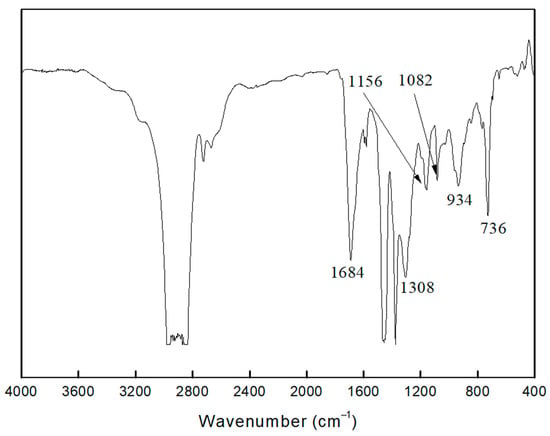
Figure 9.
FTIR spectrum of the catalysts.
2.2.3. XRD
The powder X-ray diffraction of the catalyst sample is shown in Figure 10. The signals at the 2θ of 38.3°, 44.5°, 64.7°, and 77.8° are due to the stainless-steel sample holder. Anhydrous chloride magnesium shows sharp peaks at 16.3°, 28° to 37°, and 50.5°. This indicates that the degree of crystallization is high, and this structure is disadvantageous for obtaining a high titanium tetrachloride loading. The very strong peak of the MgCl2 support of the catalyst at 16.3° disappears and the peaks at 28° to 37° are partially broken, forming a broad low peak as the two peaks are combined into a single peak and the junction of the two peaks becomes blurred. The intensity of the peak at 50.4° decreases, indicating that the MgCl2 crystal plane is destroyed. TiCl4 entering the middle of the chlorine layer structure of MgCl2 accelerates the fracture of the MgCl2 crystal, making the crystal structure of the catalyst more disordered [23,24]. This disordered structure allows the active component to load onto the MgCl2 support, which is important for catalytic activity. At the same time, it gives rise to a good morphology of the catalyst particles and the polypropylene products.
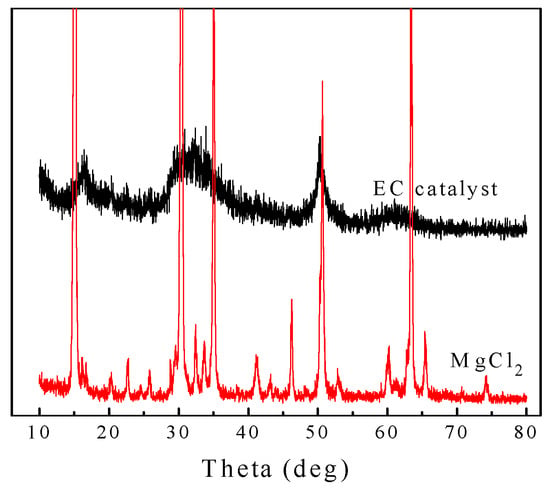
Figure 10.
XRD analysis of the MgCl2 and the catalysts.
2.2.4. GC/MS
To measure the residual surfactant and the electron donor reagent, GC/MS analysis was performed. The MS spectrum confirms that the two peaks nearly at 6 min and 8 min displayed in the GC spectrum correspond to dodecyl methacrylate and di(ethylhexyl)phthalate (DEHP), respectively. The in situ obtained DEHP can simplify the catalyst synthesis process and is significantly beneficial for the industry.
2.3. Propylene Polymerization
Table 2 demonstrates the catalyst polymerization performance of the catalytic system. The system exhibits high activity, high bulk density, and high stereospecificity. The polymerization temperature is a factor affecting the catalytic activity and the property of polypropylene. The influence of polymerization temperature on the catalytic activity and molecular weight of polymerization products is shown in Run 1–4 of Table 2. It can be seen that the catalytic activity increases with the increase in polymerization temperature, and the increased amplitude decreases when the polymerization temperature reaches 70 °C. The molecular weight of the product decreased with the increase in polymerization temperature, which was in line with the rule of Ziegler-Natta catalyst for propylene polymerization [25]. From 40 °C to 70 °C, with the increase in reaction temperature, the catalytic activity increases because of the following two aspects: one is that, with the increase in reaction temperature, the chain growth rate constant of the active center increases, which leads to the increase in catalytic activity; and the other is that, with the increase in reaction temperature, the reaction ability of TEA increases, and more potential active centers are activated, resulting in the increase in the total number of active centers, which improves the activity of the catalyst.

Table 2.
Results of the bulk polymerization of propylene 1.
With the increase of reaction temperature, the molecular weight of the polymer decreases, which is because the molecular weight of the polymer is related to the rate of chain growth and chain transfer. The effect of reaction temperature on the molecular weight of the obtained polymer is mainly realized by influencing the rate constants of chain growth and various chain transfer reactions. The faster the chain growth rate and the slower the chain transfer rate, the larger the molecular weight of the polymer. With the increase of temperature, the rate constants of chain growth and chain transfer reaction will increase. If the increase of chain growth rate constant is less than that of chain transfer rate constant, the molecular weight of polymer will decrease.
The effect of polymerization temperature on isotacticity and melting point (Tm) of polypropylene is shown in Run 1–4 of Table 2. It can be seen that, with the increase of reaction temperature, the isotacticity of the polymer decreases, and the melting point of polymer decreases with the increase in the reaction temperature, which also conforms to the basic rule of Ziegler-Natta catalyst for propylene polymerization [25]. With the increase in temperature, the orientation ability of the catalyst decreases, which may be due to the different influence of temperature on different active centers. It can be simply considered that there are isotactic and random active centers in the catalyst, and the isotacticity of the product polypropylene is just the reflection of the proportion of isotactic compounds produced by isotactic active centers in the total active products of the catalyst. With the increase in reaction temperature, the number and chain growth constant of isotactic active centers increase less than that of random active centers, so that the proportion of isotactic products in the total products of catalyst polymerization decreases, and the isotacticity of polymerization products also decreases correspondingly. The melting point of the polymer is mainly controlled by the molecular weight and crystallinity of the polymer. The higher the isotacticity, the higher the molecular weight, the better the crystallinity and the higher the melting point.
H2 is the most widely used chain-transfer agent for molecular weight control in industrial practice with Ziegler-Natta systems. It was found that H2 concentration has a certain effect on the catalyst performance (Run 3, 5, 6, Table 2). The obtained results showed that the productivity was stabilized and the polymer molecular weight decreased with the increase of H2 loading. This is better for industry production. Increasing the H2 concentration may increase the rate of the chain transfer reaction, which consequently lowers the molecular weight and isotacticity II value of the resulting polymer [26,27,28,29].
3. Materials and Methods
3.1. Materials
All of the reagents and catalysts used in this work were manipulated by the Schlenk technique. Triethylaluminum (TEA), 20% di-n-butyl magnesium in heptane, and 1,2-phthaloyl dichloride were supplied from Aldrich. TiCl4; poly-dodecene, and dodecyl methacrylate were purchased from JiangTian Chemical reagents Co., Ltd. (Tianjin, China). The n-butyl chloride and 2-ethyl-1-hexanol (2-EHA) were purchased from Guangfu Chemical reagents Co., Ltd. (Tianjin, China). Toluene, n-decane, and hexane were purchased from DaJi Chemical reagents Co., Ltd. (Tianjin, China).
3.2. Catalyst Preparation
The main reactions of the catalyst preparation are presented in the patent [29]. The first stage of the preparation consisted of the in situ formation of a liquid/liquid two-phase system where one phase was a solution of the catalyst components in an inert solvent. In the first step of stage 1, butyl octyl magnesium (BOMAG) and 2-ethyl-1-hexanol were reacted to form magnesium alkoxide. In step 2, the magnesium alkoxide formed in step 1 was allowed to react with phthaloyl dichloride (PDC) and n-butyl chloride, and the MgCl2/DEHP complex was formed. In step 3, the MgCl2/DEHP complex was reacted with TiCl4 and a liquid/liquid two-phase system was formed. In the second stage, the catalyst droplets were stabilized through the addition of a surfactant (emulsification). In the final stage, the solidification of the catalyst droplets was achieved by changing the reaction conditions of the emulsion system. The catalyst particles were then isolated and dried [28].
3.3. Characterization
After catalyst sample dissolution in H2SO4, Ti was oxidized with H2O2 and analyzed by visible spectrophotometry at 410 nm [29]. The amount of Cl was determined by the classic method of precipitation of AgCl with AgNO3, and Mg was determined by the titrometry of the catalyst acid solution with EDTA. The DEHP content was determined by the internal standard method with gas chromatography. The particle size distributions of the catalysts were measured using a laser particle size analyzer (Mastersizer 3000E).
Catalyst samples produced under different reaction conditions were mounted on aluminum stubs using a double-sided conductive carbon tape under a nitrogen atmosphere and sputter-coated with gold (15 nm thickness) to make them conductive. SEM was carried out using a JEOL 840 instrument, and a Princeton Gamma-Tech (PGT) with an Omega detector was used for the EDS measurements.
A Bruker AXS, D8 Advance X-ray diffractometer was used for the powder X-ray diffraction measurements. The catalyst sample was placed on the special sample holder made of stainless steel, and the holder was sealed with a thin film so that the measurement could be performed in inert conditions.
The mid-IR spectra of the catalyst samples were measured using a Nicolet Impact 400 D infrared spectrometer. The equipment was mounted inside a glove box so that samples could be measured using the inert diffuse reflectance infrared Fourier transform (DRIFT) method. The measurement range was 4000–650 cm−1.
3.4. Propylene Polymerization
Propylene bulk polymerizations were carried out in a stirred 2 L tank reactor. TEA was used as the cocatalyst, and cyclohexylmethyldimethoxysilane (CHMDMS) was used as the external donor. Designated amounts of TEA, external donor, solid catalyst powder, and H2 were successively introduced into the reactor. Liquid propylene (500 g) was added to start the polymerization at 70 °C for 60 min.
4. Conclusions
In summary, the emulsion technique represents a unique approach for the preparation of spherical catalysts. A perfectly spherical Ziegler-Natta catalyst for propylene polymerization was obtained via the in situ emulsion technique using dodecyl methacrylate and poly-dodecene as surfactants. FTIR and GC-MS confirmed the presence of in situ formed DEHP as the internal donor. The preparation conditions and the presence of surfactants significantly affected the morphology of the catalyst. The catalyst used for the bulk polymerization of propylene exhibits high catalytic activity, high stereospecificity, and high hydrogen response-ability.
Author Contributions
Y.W. performed the experiments and analysis; J.L. contributed to the main part of manuscript writing; W.D. and T.J. equally contributed to the conception and design of the research originality. All authors have read and agreed to the published version of the manuscript.
Funding
This research was funded by the Natural Science Foundation of Tianjin (18JCYBJC89200), the PetroChina Innovation Foundation (2018D-5007-0502), and the Project from Tianjin Education Commission (2017KJ018, 2017KJ017).
Data Availability Statement
The data presented in this study are available on request from the corresponding author. The data are not publicly available due to restrictions of the institution’s privacy policy.
Conflicts of Interest
The authors declare no conflict of interest.
References
- Ziegler, K.; Holzkma, P.E.; Breil, H. Results and development of a discovery. Angew. Chem. 1955, 67, 541–547. [Google Scholar] [CrossRef]
- Natta, G. Catalysts and Polymerization. Polym. J. Sci. 1995, 16, 35. [Google Scholar]
- Ballard, D.G.H. Pi and Sigma Transition Metal Carbon Compounds as Catalysts for the Polymerization of Vinyl Monomers and Olefins. Adv. Catal. 1973, 23, 263–325. [Google Scholar]
- Zheng, W.; He, A.; Liu, C.; Shao, H.; Wang, R. The influences of alkylaluminium as cocatalyst on butene-1 polymerization with MgCl2-supported TiCl4 Ziegler-Natta catalysts. Polymer 2020, 210, 122998. [Google Scholar] [CrossRef]
- Galli, P.; Luciani, L.; Cecchin, G. Advances in the polymerization of polyolefins with coordination catalysts. Angew. Macromol. Chem. 1981, 94, 63–89. [Google Scholar] [CrossRef]
- Mikenas, T.B.; Koshevoy, E.I.; Zakharov, V.A. Effect of the Structure of Titanium–Magnesium Catalysts on the Morphology of Polyethylene Produced. J. Polym. Sci. Part A Polym. Chem. 2017, 55, 2298–2308. [Google Scholar] [CrossRef]
- Gianini, U. Polymerization of olefins with high activity catalysts. Macromol. Chem. Suppl. 1981, 5, 216–229. [Google Scholar] [CrossRef]
- Fregonese, D.; Glisenti, A.; Mortara, S.; Rizzi, G.A.; Tondello, E.; Bresadola, S. MgCl2/TiC14/AlEt3 catalytic system for olefin polymerization: A XPS study. J. Mol. Catal. A Chem. 2002, 178, 115–123. [Google Scholar] [CrossRef]
- Kashiwa, N. The discovery and progress of MgCl2-Supported TiCl4 Catalysts. J. Polym. Sci. Part A Polym. Chem. 2004, 42, 1–8. [Google Scholar] [CrossRef]
- Luo, Z.; Zheng, T.; Li, H.; Zhou, Q.; Wang, A.; Zhang, L.; Hu, Y. Asubmicron spherical polypropylene prepared by heterogeneous Ziegler–Natta catalyst. Ind. Eng. Chem. Res. 2015, 54, 11247–11250. [Google Scholar] [CrossRef]
- Zheng, W.P.; Ma, Y.P.; Du, D.L.; He, A.H.; Shao, H.F.; Liu, C.G. Polymerization Kinetics of Propylene with the MgCl2-Supported Ziegler-Natta Catalysts—Active Centers with Different Tacticity and Fragmentation of the Catalyst. Chin. J. Polym. Sci. 2021, 39, 70–80. [Google Scholar] [CrossRef]
- Kaminsky, W. Polymerization catalysis. Catal. Today 2000, 62, 23–34. [Google Scholar] [CrossRef]
- Cho, H.S.; Lee, W.Y. Synthesis of inorganic MgCl2-alcohol adduct via recrystallization method and its application in supported organometallic catalysts for the polymerization of ethylene with 1-hexene. J. Mol. Catal. A Chem. 2003, 191, 155–165. [Google Scholar] [CrossRef]
- Choi, J.H.; Chung, J.S.; Shin, H.W.; Song, I.K.; Lee, W.Y. The effect of alcohol treatment in the preparation of MgCl2 support by a recrystallization method on the catalytic activity and isotactic index for propylene polymerization. J. Catal. 1996, 32, 405–410. [Google Scholar] [CrossRef]
- Liu, B.; Nitta, T.; Nakatani, H.; Terano, M. Stereospecific Nature of Active Sites on TiCl4/MgCl2 Ziegler-Natta Catalyst in the Presence of an Internal Electron Donor. Macromol. Chem. Phys. 2003, 20, 395–402. [Google Scholar] [CrossRef]
- Lin, J.S.; Catlow, C.R.A. Quantum Mechanical study of TiCl4/MgCl2-supported Ziegler-Natta catalysts. J. Catal. 1995, 157, 145–152. [Google Scholar] [CrossRef]
- Koskinen, J.; Garoff, T.; Louhelainen, J.; Koskinen, J. Preparation of Solid Ziegler Catalyst by Using a Multifunctional, Pivoting, Inclinable Reactor and the Equipment. U.S. Patent 5,472,923, 5 December 1995. [Google Scholar]
- Koskinen, J.; Garoff, T. Method for the Preparation of a Particulate Carrier for a Polymerization Catalyst. U.S. Patent 5,468,698, 21 November 1995. [Google Scholar]
- Albizzati, E. Process for Preparing Spheroidally Shaped Products, Solid at Room Temperature. U.S. Patent 4,469,648, 4 September 1984. [Google Scholar]
- Udayakumar, S.; Ibrahim, N.; Chien, C.Y.; Wahab, S.A.R.S.A.; Noor, A.F.M.; Ramakrishnan, S. Synthesis of Ziegler-Natta Catalyst using Malaysian Ilmenite Derived TiCl4 via Recrystallization Method: A Statistical Approach. Bull. Chem. React. Eng. Catal. 2020, 15, 687–697. [Google Scholar] [CrossRef]
- Mori, H.; Higuchi, T.; Otsuka, N.; Terano, M. High resolution transmission electron microscope observation of industrial high performance Ziegler catalysts. Macromol. Chem. Phys. 2000, 201, 2789–2798. [Google Scholar] [CrossRef]
- Ratanasak, M.; Parasuk, V. Roles of malonate donor on activity and stereoselectivity of Ziegler–Natta catalyzed propylene polymerization. J. Organomet. Chem. 2015, 775, 6–11. [Google Scholar] [CrossRef]
- Zhong, C.; Gao, M.; Mao, B. Effect of high polymerization temperature on the microstructure of isotactic polypropylene prepared using heterogeneous TiCl4/MgCl2 catalysts. J. Appl. Polym. Sci. 2003, 90, 3980–3986. [Google Scholar] [CrossRef]
- Pater, J.T.; Weickert, G.; Van Swaaij, W.P. Polymerization of liquid propylene with a 4th generation Ziegler-Natta catalyst-influence of temperature, hydrogen and monomer concentration and prepolymerization method on polymerization kinetics. Chem. Eng. Sci. 2002, 57, 3461–3477. [Google Scholar] [CrossRef]
- Pater, J.T.; Weickert, G.; van Swaaij, W.P. Propene bulk polymerization kinetics: Role of prepolymerization and hydrogen. Chem. Eng. Sci. 2002, 57, 3461–3465. [Google Scholar] [CrossRef]
- Kissin, Y.V.; Zhou, Q.; Li, H.; Zhang, L. Active centers in propylene polymerization catalysts of the fourth generation. J. Catal. 2015, 332, 156–163. [Google Scholar] [CrossRef]
- Denifl, P.; Leinonen, T. Process for Preparing an Olefin Polymerization Catalyst Component. U.S. Patent 7271119B2, 18 September 2007. [Google Scholar]
- Rönkkö, H.L.; Knuuttila, H.; Denifl, P.; Leinonen, T.; Venäläinen, T. Structural studies on a solid self-supported Ziegler–Natta-type catalyst for propylene polymerization. J. Mol. Catal. A Chem. 2007, 278, 127–134. [Google Scholar] [CrossRef]
- Kunii, D.; Levenspiel, O. Fluidization Engineering; Wiley: New York, NY, USA, 1969; pp. 105–106. [Google Scholar]
Publisher’s Note: MDPI stays neutral with regard to jurisdictional claims in published maps and institutional affiliations. |
© 2021 by the authors. Licensee MDPI, Basel, Switzerland. This article is an open access article distributed under the terms and conditions of the Creative Commons Attribution (CC BY) license (https://creativecommons.org/licenses/by/4.0/).